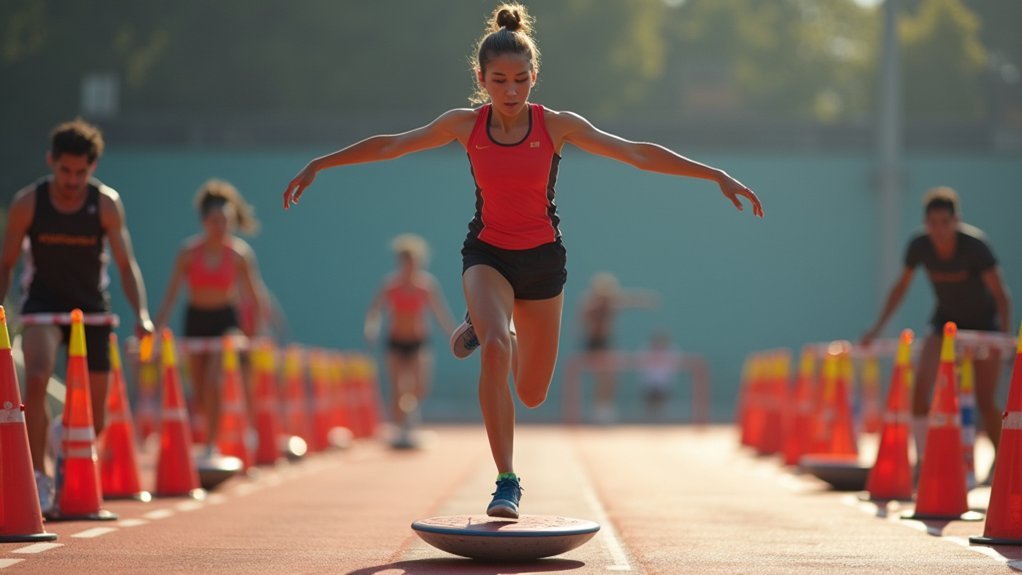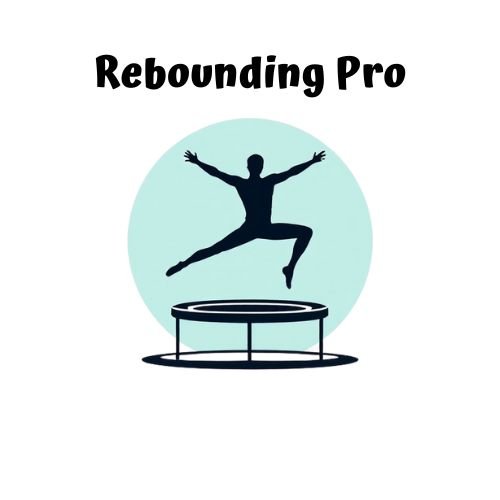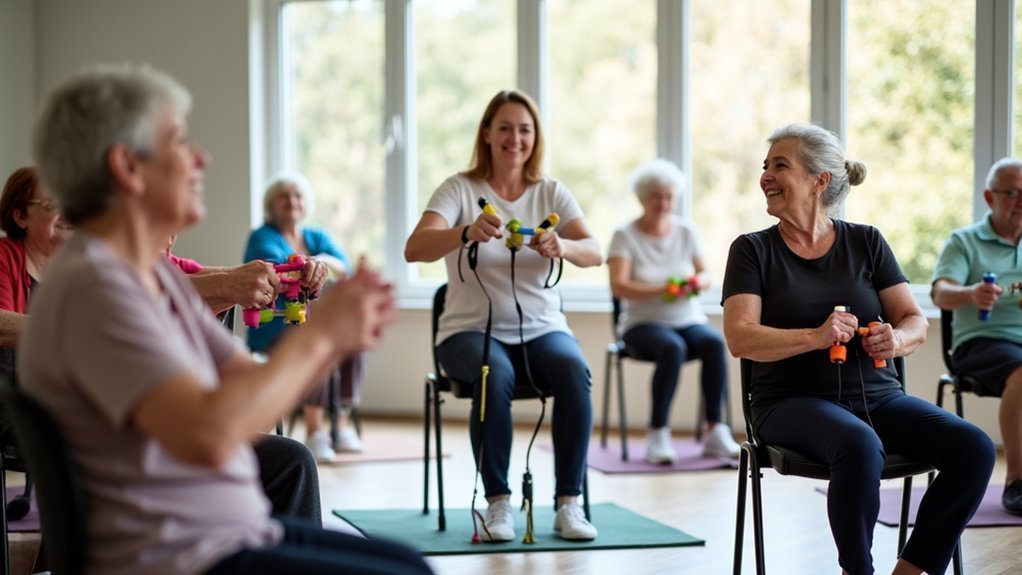Multi-directional balance training activates complex neural networks that static exercises can’t match. You’ll enhance proprioception—your body’s internal GPS—and improve vestibular function through movements across all three planes. This all-encompassing approach strengthens your neuromuscular system, increases movement efficiency, and builds injury resilience. Regular practice for 4-8 weeks creates new neural pathways, improving stability and coordination. The following details reveal how you can transform your stability with specific directional techniques.
Understanding the Three-Dimensional Nature of Balance

When we talk about balance, we’re actually describing a complex skill that exists in three dimensions, not just the simple act of not falling over. Your body constantly processes information from multiple sensory systems—visual, vestibular, and proprioceptive—to maintain stability in space.
Think of your balance as operating along three planes: the sagittal (forward-backward), frontal (side-to-side), and transverse (rotational). Each dimension requires different muscle activations and coordination patterns. You’re not just standing still; you’re actively making micro-adjustments to maintain equilibrium.
This spatial awareness isn’t merely physical—it’s cognitive too. Your brain processes depth perception, remembers spatial relationships, and focuses attention on potential obstacles, all while coordinating your body’s response to maintain stability in your three-dimensional world. Much like ecological systems, human balance demonstrates both stability and adaptability, though it’s more dynamic and chaotic than perfectly equilibrated.
The Neuromuscular Benefits of Multi-Directional Training
Your training muscles and nerves benefit tremendously when you challenge your body through varied directions of movement.
Multi-directional exercises activate complex neural networks, strengthen your proprioceptive system, and fine-tune motor control patterns that static training simply can’t match.
These neuromuscular adaptations don’t just improve balance—they transform your athletic capacity while simultaneously building injury resilience. Research demonstrates that young soccer players who incorporated multidirectional plyometrics into their training showed significant improvements in dynamic postural control across seven different movement axes.
Neural Network Activation
The brain’s neural pathways spring into action during multi-directional training, creating a complex symphony of signals that strengthen your entire neuromuscular system.
Similar to how activation functions in neural networks introduce non-linearity for pattern recognition, your body learns to process varied movement inputs simultaneously.
When you train in multiple directions, you’re fundamentally upgrading your brain’s processing power. Your neural networks must quickly integrate sensory feedback from different angles, optimizing muscle activation patterns and improving response time. This process resembles how hidden layers perform computations on different features before transferring results to output movements.
This constant adaptation promotes neuroplasticity—your brain literally rewires itself to better handle complex movements.
The cognitive demands of multi-directional exercises enhance your motor learning capabilities, making your brain more efficient at recognizing and responding to movement patterns you’ll encounter in daily life and sports.
Proprioceptive System Enhancement
At the core of your balance system lies proprioception—your body’s sixth sense that constantly monitors position, movement, and spatial orientation. When you incorporate multi-directional training, you’re fundamentally upgrading this internal GPS system.
Training your proprioceptive network through varied movement patterns enhances your joint position sense and neuromuscular efficiency. Studies show that consistent practice over 4-8 weeks markedly improves both anterior-posterior and medio-lateral stability. The star excursion test provides an excellent measure of this dynamic postural control in athletes, particularly young soccer players.
Your brain undergoes cortical reorganization, creating more efficient neural pathways for movement execution. Muscle vibration techniques above 30 Hz can amplify these benefits, especially during longer sessions.
The improvements aren’t temporary—they persist beyond the training period, with measurable stability benefits observed up to 16 weeks post-training. This enhanced proprioceptive foundation ultimately translates to better athletic performance and reduced injury risk.
Motor Control Refinement
Beyond basic strength and flexibility, motor control represents the brain’s ability to orchestrate precise, coordinated movements when maneuvering your environment.
Through multi-directional training, you’ll develop neuromuscular adaptations that enhance your body’s movement efficiency and coordination.
When you incorporate varied movement patterns, your nervous system learns to:
- Engage multiple muscle groups simultaneously, developing complex motor patterns that improve reaction time and precision
- Adapt quickly to unpredictable situations, enhancing your stability during rapid direction changes
- Refine movement efficiency, allowing for more controlled actions with less energy expenditure
This neurological engagement combines with improved muscle elasticity to reduce injury risk while enhancing performance.
You’ll notice better body positioning, quicker shifts between movements, and increased confidence when navigating challenging physical environments. Training with an eight-vector system helps develop complete 360° movement capabilities, ensuring you’re prepared for any directional challenge.
How Directional Rebounding Enhances Proprioception
Directional rebounding dramatically improves your proprioception by stimulating joint receptors throughout your body with each bounce and landing.
You’ll notice enhanced balance when you incorporate multi-surface challenges that force your body to adapt to varying levels of stability and resistance. These activities are particularly effective for injury prevention as they strengthen the natural feedback mechanisms your body uses to maintain stability.
Your vestibular system will quickly adapt to these dynamic movements, helping you maintain better spatial awareness and equilibrium during everyday activities and athletic performance.
Rebounding Activates Joint Receptors
Joint receptors spring to life during rebounding exercises, creating a proprioceptive feast for your nervous system. As you bounce and change directions, your body experiences dynamic compression forces and variable joint angles that stimulate these specialized sensors.
These receptors excel at detecting position extremes, helping you avoid dangerous hyperextension while enhancing movement accuracy. This is particularly important as joint position sense, a critical sub-modality of proprioception, directly impacts movement planning and injury prevention.
- Multi-directional rebounds create 3D spatial challenges that force your joints to continuously triangulate position across all movement planes.
- The pseudo-weightlessness phase during jumps demands rapid receptor feedback for mid-air adjustments.
- Eccentric loading during landing phases maximally engages joint stabilizers and their associated receptors.
With regular practice, you’ll develop enhanced receptor sensitivity, reducing response time to positional changes and improving your ability to detect subtle joint-angle deviations during complex movements.
Multi-Surface Balance Challenges
When you venture beyond single-plane movements, your brain’s proprioceptive system faces exponentially more complex challenges. Training on unstable surfaces enhances your dynamic posture control, forcing your musculoskeletal system to adapt quickly to environmental changes. Recent studies show that basketball players engaging in unstable surface training demonstrated significant improvements in both balance performance and passing accuracy compared to those training on stable surfaces.
| Surface Type | Proprioceptive Benefit | Performance Impact |
|---|---|---|
| Foam Pads | Enhanced sensory integration | Improved daily balance |
| BOSU Ball | Increased joint stability | Greater passing accuracy |
| Balance Discs | Reduced center of pressure sway | Enhanced agility and speed |
Vestibular System Adaptation
Your vestibular system—the intricate biological gyroscope housed within your inner ear—undergoes remarkable adaptation when challenged by multi-directional movement patterns.
Rebounding in various directions activates distinct semicircular canal-otolith combinations, enhancing your spatial awareness while preventing sensory habituation through unpredictable motion vectors.
When you engage in multidirectional training, your brain forges stronger connections between proprioceptive and vestibular inputs:
- Bimodal integration occurs as vestibular-proprioceptive neurons adapt to combined sensory inputs, enhancing central neural plasticity.
- Cerebellar recalibration is triggered by variable velocity inputs, forcing your brain to update internal models for balance recovery.
- Sensory reweighting improves as your brain learns to prioritize the most reliable input when vestibular and proprioceptive signals conflict.
This training approach is particularly effective for developing body awareness as receptors in muscles and joints continually send information about position to the brain.
Breaking Through Plateaus With Varied Movement Patterns
Many fitness enthusiasts experience frustrating plateaus after weeks or months of consistent training, as the body adapts to familiar movement patterns and no longer responds with progress.
You can overcome these stagnant periods by introducing movement variability into your routine. By incorporating diverse movement patterns, you’ll target underdeveloped muscle groups, engage different muscle fibers, and improve motor learning capabilities. This approach helps identify and address weaknesses that standard exercises might miss.
Multi-directional training reduces your risk of repetitive strain injuries while enhancing neuromechanical matching within muscle units. Your body becomes more adaptable as you practice movements from different angles and planes. Training various rotation exercises teaches your muscle groups to work in harmony throughout the entire kinetic chain, improving overall movement efficiency.
The result? Renewed progress as your nervous system faces fresh challenges, creating new neural pathways and breaking through performance barriers that once seemed insurmountable.
Practical Rebounding Exercises for Directional Balance

You’ll improve your rebounding stability by mastering controlled deceleration techniques that teach your body to absorb momentum safely in multiple directions.
Practice multi-surface landing drills where you alternate between soft and firm areas of your trampoline to challenge your proprioception.
These directional balance exercises not only strengthen your stabilizer muscles but also prepare your body for real-world movements where surfaces and momentum constantly change. Incorporating one-minute intervals with alternating foot positions helps develop unilateral strength and coordination essential for daily activities.
Controlled Deceleration Techniques
When athletes master the art of stopping quickly, they dramatically reduce their risk of injury while enhancing performance.
Effective deceleration training strengthens your ankle, knee, and hip joints through controlled absorption of force during rapid directional changes.
The initial rearward body lean helps create better braking forces and provides the foundation for controlled deceleration in any sport-specific movement.
To develop superior deceleration skills, incorporate these techniques into your training:
- Practice lateral slides with resistance bands to enhance your side-to-side movement control and improve stability in your leading leg.
- Perform tuck jumps with directed landings to refine your vertical jump control and landing precision.
- Integrate backpedaling drills to master rearward movement control—crucial for sports requiring quick directional shifts.
As you progress, gradually shift from static positions to dynamic movements, adding resistance and complexity to challenge your body’s ability to control momentum effectively.
Multi-Surface Landing Drills
Multi-surface landing drills represent the next evolution in balance training, challenging athletes to adapt to a variety of terrains while maintaining perfect form. These exercises develop your body’s proprioceptive system, enhancing your ability to react instinctively to changing environments.
Start with basic depth drop drills, stepping off elevated platforms and focusing on stable landings. Progress to multi-directional hops across different surfaces, from foam to hardwood to grass. Using cabo foam trainers provides an excellent uneven surface that strengthens the foot and ankle complex while enhancing balance requirements. Incorporate ladder drills to challenge your speed while maintaining control.
For advanced training, try balance boards or CobbleFoam to simulate uneven terrain. These unstable surfaces force your nervous system to adapt rapidly, reducing injury risk and improving performance.
Adapting Balance Training for Different Fitness Levels
Balance training isn’t a one-size-fits-all approach, especially when incorporating multi-directional movements into your routine.
You’ll need to adjust exercises based on your current abilities while gradually challenging yourself for ideal results.
Beginners should start with simple movements and use stability aids like walls or balance beams. Progress can include holding positions longer or gradually removing support as your stability improves. If you’re more advanced, integrate complex movements on unstable surfaces and combine with strength training for enhanced performance.
For older adults or those with mobility issues, prioritize safety with low-impact exercises and slower progression.
- Beginner level: Focus on single-plane movements first, like one-leg stands, before attempting multi-directional challenges
- Advanced level: Add dynamic environments that mimic unpredictable real-world conditions
- Modified approach: Customize based on specific goals—whether rehabilitation, athletic performance, or fall prevention
The Science Behind Destabilization Training Effects

The science behind destabilization training reveals why controlled instability can dramatically improve your balance and coordination. When you train on unstable surfaces like wobble boards or BOSU balls, you’re forcing neuromuscular adaptation through constant postural challenges.
Your sensorimotor system responds by integrating sensory inputs with motor responses more efficiently. This creates enhanced muscle activation patterns and improved core strength. Research shows these unstable training environments actually accelerate motor learning and retention compared to stable surfaces.
The physiological benefits extend beyond immediate balance improvements. Your brain develops faster reactive capabilities, particularly beneficial for fall prevention. Perturbation-based training has been shown to significantly reduce falls in older adults and individuals with conditions like Parkinson’s disease compared to conventional methods.
Destabilization training rewires your brain’s circuitry, creating lightning-fast protective responses when balance is threatened.
Studies indicate that neuromuscular engagement during destabilization training creates adaptations that transfer effectively to real-world situations where you might face unexpected balance challenges—making this approach particularly valuable for everyday functional movement.
Progressive Challenges: Adding Complexity to Rebounding Practice
Applying destabilization principles to rebounding requires a methodical approach to skill development.
You’ll want to progressively increase difficulty by integrating multi-planar movements that simulate game situations while challenging your balance systems.
Start with fundamental box-out positions on stable surfaces before advancing to more complex scenarios:
- Incorporate instability pads during positioning drills, forcing your proprioceptive system to continuously adjust while maintaining ideal rebounding position.
- Add cognitive layers with auditory cues during jumps—have a coach call out directions mid-flight to simulate real-game decision-making.
- Progress from 1v1 box-out competitions to small-sided games that introduce multiple variables while maintaining control over technique.
This structured progression guarantees your balance training directly translates to improved rebounding performance under game conditions. Remember that successful rebounding is fundamentally about heart and hustle, not just height or natural athleticism.
Translating Rebounding Skills to Everyday Movement
While excelling on the basketball court remains the primary focus of rebounding drills, these practiced movements offer remarkable benefits that extend far beyond the game itself.
The multi-directional nature of rebounding directly translates to improved coordination in daily activities. You’ll notice enhanced balance when maneuvering stairs or uneven surfaces, and better adaptability when carrying groceries or playing with children.
Your core strength improvements support postural stability and reduce injury risk during unexpected movements. Regular rebounding practice can be low-impact exercise suitable for people of various ages and fitness levels.
Strong core muscles from rebounding create a foundation for everyday stability, protecting your body when life throws unexpected challenges your way.
The cardiovascular benefits of rebounding strengthen your heart while being gentle on joints. Additionally, these movements stimulate lymphatic drainage, supporting your immune system and detoxification processes.
Measuring and Tracking Balance Improvements From Directional Training
Accurate assessment serves as the foundation for any effective balance training program. When implementing multi-directional training, you’ll need reliable metrics to track your progress.
Research shows considerably greater improvements in gait and balance measures with multi-directional approaches compared to traditional methods.
- Utilize standardized tests like the Fullerton Advanced Balance scale, Timed Up and Go (TUG), and Four Square Step Test (FSST) to establish baselines and track improvements.
- Schedule regular follow-up evaluations to monitor sustained balance enhancements over time.
- Incorporate turning velocity and fast gait speed measurements to assess dynamic balance during changing movements.
To maximize effectiveness, make certain your training includes sessions at least three times weekly for several weeks. Combining physical balance exercises with cognitive challenges can yield enhanced outcomes for older adults particularly.
The statistical importance of your improvements will be evident through enhanced mobility, agility, and reduced fall risk.
Frequently Asked Questions
Can Multi-Directional Balance Training Reverse Existing Mobility Issues?
Yes, you can reverse existing mobility issues through multi-directional balance training. It improves your gait, stability, and neurological adaptations while strengthening affected limbs, as shown in studies with MS and stroke patients.
How Long Before Noticeable Improvements in Fall Prevention Occur?
You’ll typically see noticeable improvements in fall prevention within 8-12 weeks of consistent training. Your progress depends on your initial fitness level, exercise frequency, and whether you’re following a structured program.
Are There Age Restrictions for Beginning Multi-Directional Movement Training?
No, there aren’t age restrictions for starting multi-directional movement training. You’ll just need appropriate modifications based on your current ability. Whether you’re 8 or 80, you can begin with age-appropriate intensity and progression.
How Does Multi-Directional Training Affect Cognitive Function?
You’ll enhance cognitive functions through multi-directional training that improves your working memory, executive control, and processing speed. It promotes neuroplasticity and creates transfer effects to untrained cognitive tasks when difficulty adapts progressively.
Can Balance Training Help With Vertigo or Inner Ear Disorders?
Yes, balance training can help manage your vertigo and inner ear disorders. You’ll strengthen your vestibular system, increase movement tolerance, and may experience significant symptom improvement through targeted exercises like the home Epley maneuver.
In Summary
By incorporating multi-directional movements into your rebounding practice, you’ll develop more robust balance capabilities that serve you in real-world situations. You’re not just training your body to stabilize in one plane – you’re preparing your nervous system to respond efficiently to life’s unpredictable movements. Don’t limit yourself to forward motion; embrace lateral, diagonal, and rotational challenges to release your full balance potential.





Leave a Reply